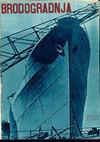一个广泛的调查流动调节器在一个fi-fi监视器
IF 4.2
4区 工程技术
Q1 ENGINEERING, MARINE
引用次数: 0
摘要
众所周知,为了为任何类型的水面舰艇提供防火保护,外部消防(EFF)系统已经普遍使用了几十年,在沿海地区也是如此。这些类型的系统存在于几种类型的船舶上,如消防船、拖船、补给船和海军舰艇。流量调节器可用于EFF系统,通过调节fi-fi监视器内的流量来提供更好的性能。本研究设计了一种消防(fi-fi)监视器,并在该监视器中安装了不同的流量调节器。在ISO 5167-3推荐的流量调节剂基础上,设计了一种独特的流量调节剂,以提高流量调节剂在水头比和流量方面的性能。利用商业计算流体动力学(CFD)求解器对不同的气流调节器的性能进行了研究。在比较不同流量调节器的数值结果之前,将数值模型与实验数据进行了验证,并采用相应的方法进行了验证。结果表明,该独特的流量调节剂对流线的调节效果良好,在流量和水头比方面优于ISO 5167-3推荐的调节剂。作为研究的最后一部分,研究了不同流量调节剂长度的影响,并确定了最佳长度。本文章由计算机程序翻译,如有差异,请以英文原文为准。
AN EXTENSIVE INVESTIGATION OF FLOW CONDITIONERS INSIDE A FI-FI MONITOR
As it is known, to provide fire protection for any type of surface vessel, external fire-fighting (EFF) systems have been commonly used for decades as well as in coastal regions. These types of systems exist on several types of vessels such as fire-fighting ships, tugboats, supply vessels and naval vessels. Flow conditioners can be used in the EFF systems to provide better performance by regulating the flow inside the fi-fi monitor. In the present study, a fire-fighting (fi-fi) monitor was designed and different flow conditioners were implemented into the fi-fi monitor. A unique flow conditioner was designed in addition to the recommended ones by ISO 5167-3 in order to improve the performance of the flow conditioner in terms of head ratio and flow rate. A commercial computational fluid dynamics (CFD) solver was used to investigate the performance of the different flow conditioners. Before comparing the numerical results of different flow conditioners, the numerical model was validated with the experimental data and verified with appropriate methods. The results showed that the unique flow conditioner successfully regulates the streamlines and it has better performance than the recommended ones by ISO 5167-3 in terms of flow rate and head ratio. As the last part of the study, the effect of unique flow conditioner length was investigated and the best length was determined.
求助全文
通过发布文献求助,成功后即可免费获取论文全文。
去求助
来源期刊

Brodogradnja
ENGINEERING, MARINE-
CiteScore
4.30
自引率
38.90%
发文量
33
审稿时长
>12 weeks
期刊介绍:
The journal is devoted to multidisciplinary researches in the fields of theoretical and experimental naval architecture and oceanology as well as to challenging problems in shipbuilding as well shipping, offshore and related shipbuilding industries worldwide. The aim of the journal is to integrate technical interests in shipbuilding, ocean engineering, sea and ocean shipping, inland navigation and intermodal transportation as well as environmental issues, overall safety, objects for wind, marine and hydrokinetic renewable energy production and sustainable transportation development at seas, oceans and inland waterways in relations to shipbuilding and naval architecture. The journal focuses on hydrodynamics, structures, reliability, materials, construction, design, optimization, production engineering, building and organization of building, project management, repair and maintenance planning, information systems in shipyards, quality assurance as well as outfitting, powering, autonomous marine vehicles, power plants and equipment onboard. Brodogradnja publishes original scientific papers, review papers, preliminary communications and important professional papers relevant in engineering and technology.
 求助内容:
求助内容: 应助结果提醒方式:
应助结果提醒方式:


